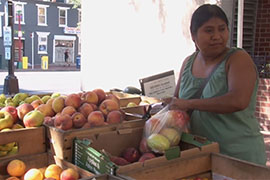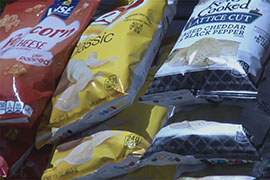- Slug: BC-CNS-Food Insecurity,760
- Sidebar: Food insecurity numbers, by county
- Interactive map (embed code below)
- Photos, video story available (thumbnails, captions below)
By SABELLA SCALISE
Cronkite News
WASHINGTON – Food advocacy groups said Apache County children had the least reliable access to healthy food in the nation in 2014, when 41.5 percent of children in the county were deemed to be “food insecure.”
But Apache County was just the most extreme example of a problem seen throughout the state, where more than one in four children was in danger of not having enough food or not having access to enough healthy food.
The state rate of 26.8 percent was third-highest in the nation for childhood food insecurity in 2014, according to “Map the Meal Gap,” a report by Feeding America. The national rate that year was 20.9 percent.
Those numbers, first reported in April, were cited again this week in the State of Obesity 2016 report by the Trust for America’s Health, which said food insecurity can contribute to obesity.
“We know children that don’t have access to fresh nutritious food, have a lifelong impact of problems,” said David Martinez, advocacy outreach specialist for St. Mary’s Food Bank in Phoenix.
“When families have low incomes, they tend to go towards more affordable and less healthy meals,” said Martinez, who has worked to deliver free nutritious meals to Apache County.
Poverty is one of the main factors behind food insecurity, making it an urban and rural problem. But in remote rural areas – like Apache County – the problem can be compounded by sheer distance to a grocery. The problem affects grownups as well: The food insecurity rate for all ages in Arizona was 17.1 percent in 2014.
“It is very difficult to be in those areas” and have access to healthy food, said Christina Economos, director of the advocacy group ChildObesity180.
“Even if a grocery trip is made once every seven or 10 days, because of transportation and distance, we need to help them get the best foods they can get,” said Economos, speaking at a panel in Washington this week on the need to improve childhood nutrition.
Albert Lang, a spokesman for Trust for America’s Health, said the trust uses the food insecurity numbers as a way to bring attention to areas with families that need help getting healthy meals.
“A family can consist of one, two or three people with limited access to adequate food or nutrition because of cost or proximity,” he said. “It is the percent of households with children that have food insecurity, not enough resources to purchase nutritious food for the family.”
Food insecurity is an Agriculture Department measure that is based on data from the Census Bureau, the Bureau of Labor Statistics and other sources. One advocate called it the “gold standard” of household nutrition measurement.
“We’ve been doing the study for a few years now, the methodology is thought out,” said Michael Kato, research analyst for Feeding America.
Alexandra Brewis Slade, co-director of the Mayo Clinic/Arizona State University Obesity Solutions Initiative, said food insecurity has to do with ecological, environmental and income inequality.
“It’s a problem that must be tackled at multiple points,” said Slade, adding that the food insecurity rankings are a sign of where Arizona should be focusing its programs.
The Arizona Department of Health services said in an emailed statement that “addressing both food insecurity and the problems caused by obesity is important.” The statement went on to say that the solution to the problem is multipronged, and includes involving doctors, nurses, families and schools.
Martinez and others said the classroom is a vital part of the solution, both in terms of providing meals to children and teaching them about nutritious eating.
They pointed to the implementation of summer lunch programs, for example, as a crucial program that can keep children from going hungry during their summer vacations.
Schools are also critical to Apache County’s efforts to fight the problem, officials there say.
The Arizona Nutrition Network has created a three-week curriculum for students from Head Start to eighth grade that teaches about proper nutrition and introduces healthy snacks to the students.
“If we teach kids from little to be healthy, when they grow … they will be healthy,” said Doris Fodera, the nutrition network coordinator for Apache County Public Health and Emergency Preparedness.
Fodera goes into the schools and works with kids on nutrition practices, cooking and how to shop smart at the grocery. She said she thinks the program is already starting to make a difference.
“It is working,” Fodera said. “It’s not all the time, but I’ve had parents tell me they are eating healthier because of the class.”
^__=
Web links:
_ Arizona childhood food insecurity: http://map.feedingamerica.org/county/2014/child/arizona
_ Arizona overall food insecurity: http://map.feedingamerica.org/county/2014/overall/arizona
_ State of Obesity 2016: http://stateofobesity.org/files/stateofobesity2016.pdf
_ Arizona obesity stats: http://stateofobesity.org/states/az/
_ Map embed code: <script id=”infogram_0_cfbb9874-df3a-4a4e-9996-9e8526ea8960″ title=”Arizona Food Insecurity Rates” src=”//e.infogr.am/js/embed.js?M5R” type=”text/javascript”></script><div style=”padding:8px 0;font-family:Arial!important;font-size:13px!important;line-height:15px!important;text-align:center;border-top:1px solid #dadada;margin:0 30px”><a target=”_blank” href=”https://infogr.am/cfbb9874-df3a-4a4e-9996-9e8526ea8960″ style=”color:#989898!important;text-decoration:none!important;”>Arizona Food Insecurity Rates</a><br><a style=”color:#989898!important;text-decoration:none!important;” href=”https://infogr.am” target=”_blank”>Create your own infographics</a></div>
^__=
SIDEBAR:
State of hunger
The share of children and of the total county population who were “food insecure” in 2014 – in danger of not having food or not having access to nutritious food, according to Feeding America.
– Apache County: 41.5 percent children; 26.4 percent overall
– Cochise County: 26.4 percent; 16.1 percent
– Coconino County: 29.5 percent; 19.9 percent
– Gila County: 32.2 percent; 18.4 percent
– Graham County: 27.6 percent; 15.8 percent
– Greenlee County: 24.0 percent; 14.2 percent
– La Paz County: 28.8 percent; 16.1 percent
– Maricopa County: 24.7 percent; 15.8 percent
– Mohave County: 31.9 percent; 19.2 percent
– Navajo County: 37.0 percent; 22.8 percent
– Pima County: 24.8 percent; 15.4 percent
– Pinal County: 25.9 percent; 15.3 percent
– Santa Cruz County: 27.8 percent; 12.2 percent
– Yavapai County: 27.1 percent; 17.0 percent
– Yuma County: 35.5 percent; 20.0 percent
^__=
Food insecurity measures the likelihood that a family may not have sufficient food or that it may get food but not fresh, nutritious foods. (Photo by Sabella Scalise/Cronkite News)
Farmers markets, like this one in Washington, D.C., are a good source of fresh, healthy food, but they may not be an option for people in “food deserts.” (Photo by Sabella Scalise/Cronkite News)
“Food insecurity” doesn’t only mean a shortage of food, but also a lack of access to healthy foods – or too much junk food that’s cheap and readily available. (Photo by Sabella Scalise/Cronkite News)


